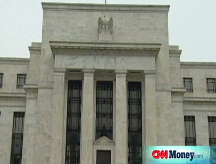Rate cut gives dollar a ride
Dollar recovers some after sinking sharply, as Federal Reserve and a host of banks around the globe cut rates.
NEW YORK (CNNMoney.com) -- The dollar was mixed against global currencies Wednesday, after nations around the globe issued emergency interest rate cuts.
In a move to boost economic growth in the midst of a worsening global financial crisis, the Federal Reserve lowered its fed funds rate by half a percentage point to 1.5%.
The Fed's move was part of a coordinated effort to lower rates by the central banks of the United States, Canada, England, the European Union, Sweden and Switzerland. The enactment was announced at 7 a.m. ET.
Investors at first cheered the move. They took out the funds they have been using for months to trade dollars and put them in stocks. Foreign stock indexes recovered, oil prices rose and U.S. stock futures soared.
But about an hour after the news, investors' mood changed and stocks and oil both fell sharply. Investors put their funds back into the perceived safety of the dollar.
"The outlook is bad," said Tom Benfer, foreign exchange vice president at the Bank of Montreal. "There is a fair amount of doubt in the marketplace that this is going to work."
Risk aversion hurts European currencies
At 4 p.m. ET, the euro bought $1.3664, up from Tuesday's close of $1.3589. The 15-nation euro was as much as 1.1% higher after the announcement, before selling off.
The British pound traded at $1.7276, down 1% from Tuesday's $1.7456. It was the lowest level for the U.K. currency since March 10, 2006. It had traded up as much as 1.2% after the banks' joint rate cut.
With an ever-worsening economic situation in Europe, investors have been selling off pounds and euros and buying up U.S. dollars. Just two days ago, the euro traded at a 14-month low.
"The dollar has been trading up since July, broadly on increasing risk aversion," said Dustin Reid, senior currency strategist at ABN AMRO. "The dollar has seen a lot of safe haven flows recently."
Traders tend to think that the U.S. economy will bounce back before those in Europe because of the U.S. government's recovery efforts.
"We got the ball rolling earlier than the other countries," said Benfer. "Even now there's disagreement in Europe about how to proceed."
Yen boosted by fear factor
On the other hand, the dollar continued its enormous plunge against the Japanese yen. The dollar fell against the yen to ¥99.83, from ¥101.47 the day before. Monday, the dollar suffered a historic collapse, falling by as much as 4.8% - the biggest one-day drop ever. The dollar fell another 0.6% Tuesday.
The yen typically increases when investors show aversion to risk.
"When you make capital and money cheaper, it's a good step theoretically," said Benfer of the rate cuts. "But we all know if the credit markets still won't lend money out, we'll be stuck in the same situation for a long time."
Benfer said that if the dollar maintains a level below ¥100, the stock markets could remain mired in their recent funk. Indeed, stocks traded much lower Wednesday. ![]()




